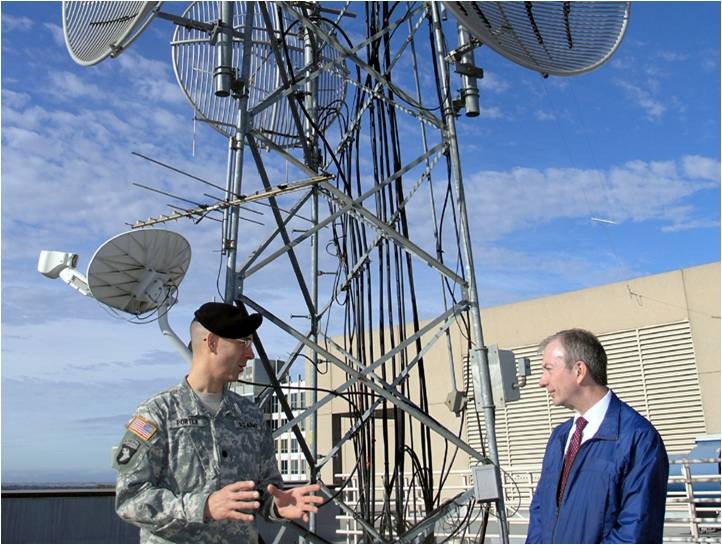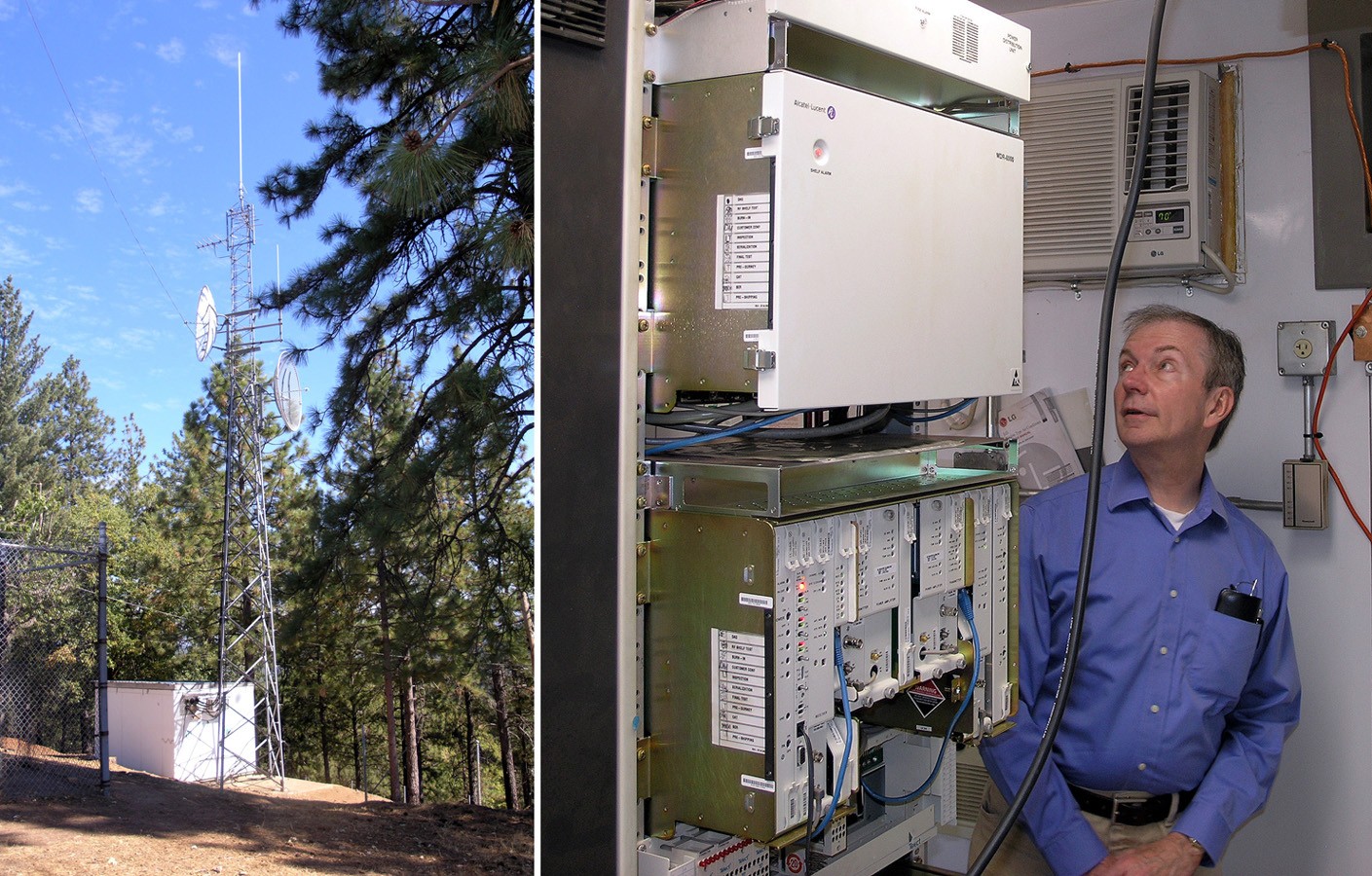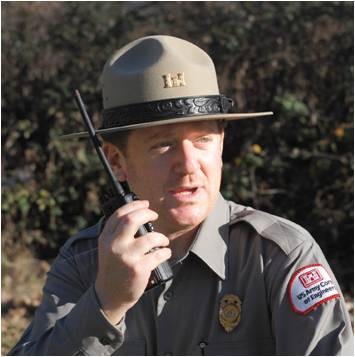SACRAMENTO, Calif. - The U.S. Army Corps of Engineers (USACE) Sacramento (Calif.) District will be able to better perform its missions of providing flood risk mitigation, disaster response and civil and military construction management, thanks to the upgrade of its radio system from aging analog equipment to a modern digital system by the Product Manager, Defense Wide Transmission Systems (PM DWTS).
The upgrade, which started in Sept. 2008 and is scheduled to be completed by the end of March 2009, is part of the DoD-wide initiative to relocate frequencies from the 1710 to 1755 MHz range to free that spectrum for commercial use to meet demands for new wireless services, in accordance with Public Law H. R. 5419. PM DWTS, part of the DCATS (Defense Communications and Army Transmission Systems) Project Office of the Program Executive Office, Enterprise Information Systems (PEO EIS), has partnered with USACE though the U.S. Army Spectrum Management Office, part of the Army Chief Information Office (CIO)/G6 to relocate USACE's frequencies, and in the process, is modernizing USACE's radio system infrastructure.
According to PM DWTS project leader Al Thompson, PM DWTS upgraded USACE's system with modern digital microwave radio equipment at 10 sites throughout northern California. "We also provided these sites with sufficient power infrastructure and HVAC (heating, venting and air conditioning) systems and reinforced or relocated their microwave towers, if needed," said Thompson, along with providing a comprehensive integrated logistics support package, including training, spares and two years of operations and maintenance support.
The U.S. Army Information Systems Engineering Command (ISEC) provided engineering support and quality control for the project, said Thompson, with Computer Sciences Corporation serving as prime contractor and LGS Innovations as subcontractor.
Lt. Col. Clyde Richards, the Product Manager, Defense Wide Transmission Systems, noted that Thompson is also executing projects to relocate frequencies for USACE's Portland (Ore.) District, Los Angeles (Calif.) District and New England District; the Defense Criminal Investigative Service; and Ft. Rucker, Ala. "Al has done a great job in putting a plan together, assembling a team and executing the Army portion of this DoD initiative," said Richards.
According to Lt. Col. Jim Porter, Deputy District Engineer of the USACE Sacramento District, the DoD initiative to relocate frequencies was "a blessing in disguise," as it brought with it the funding to update their aging radio system, which was comprised of all-analog components that were up to 25 years old.
"For us, this is a win," said Porter. "We had radio equipment at sites that was installed in the 1970's, and over time, as equipment was added, we wound up with a mix-and-match of technology. We wondered how it would work when we transitioned to the 1755 to 1860 MHz range - now we've replaced all this aging equipment with a uniform, modern digital system."
Porter said that the modern radio system will help personnel of the USACE Sacramento District perform their key mission of managing and maintaining levees and river systems for flood risk reduction, noting that the city of Sacramento is at the confluence of the American and Sacramento rivers and that some 6,000 miles of levees snake through the northern half of the state.
"Pre-Hurricane Katrina, Sacramento's risk of flooding was the greatest of any major U.S. city - including New Orleans," said Porter. "I remember a former FEMA (Federal Emergency Management Agency) official saying that if you had told him, pre- Hurricane Katrina, that an American city was under water, he'd have asked 'what happened to Sacramento''"
USACE is the nation's largest recreational area provider
Porter said the radio system upgrade would also help the Sacramento district in its mission to operate parks, lakes and recreation areas at nine flood risk mitigation project sites and one river project site.
"The Corps of Engineers operates the largest recreational system in the country," said Porter. "Our district gets more than two million visitors at our parks, lakes and recreation areas each year. Park Rangers are the primary users of our radio system."
And therein lay an issue, said Thompson, in that the Sacramento District's Park Rangers use analog handheld radios and there was no funding to provide new digital handheld radios.
"The trick was to connect the legacy handhelds to the digital backbone," said Thompson, "because there were no 'as-built' drawings of the legacy network. We had to reverse-engineer the handheld network to reconnect the handhelds to the new digital backbone."
According to Jonathan Friedman, Senior District Park Ranger, the meshing of the analog handhelds with the digital backbone worked like a charm. "We have seamless transmission," said Friedman. "The signal is clearer and much stronger."
It even beats cell phones. For one thing, Friedman said, with a cell phone, you can talk only to the person on the call, while with a radio, you can talk to anyone on that frequency. "So if we want to get the word out about the release of water on a damn, a road closure or vessel traffic on a lake, we can reach all of our people with one radio transmission instead of a having to make separate phone calls to each person," said Friedman.
Also, cell phones have a nasty tendency to lose signal near hills, canyons and ravines - an important consideration when you spend a lot of your day in the foothills of the Sierra Nevada mountains, with peaks rising to more than 14,000 feet high.
"Plus, in a natural disaster, one of the first things to go are cell phones," said Friedman. "We really depend on our radios to communicate directly with Rangers in the field when we have flood events and natural disasters."
Because the backbone is digital, Friedman said, Park Rangers can now transmit info other than voice. For example, he said, if a sensor on a river was communicating information about water flow, they had to send it to a server and bring it up on a computer, with, maybe a lapse of a half-hour to receive the data. Now, they can stream that data constantly and have actual, real-time data.
"The doors are now open to us," said Friedman. "We can outfit Rangers with laptop computers to send data back and forth - such as topographic maps for search and rescue missions, using this new digital capability."
Door to digital world also opens for USGS in northern California
Another federal organization benefitting from the USACE Sacramento District microwave radio system upgrade is the U.S. Geological Survey (USGS), which collects, monitors and analyzes data about the Earth to provide scientific understanding about natural resource conditions and issues. USACE has a cooperative agreement with USGS, under which USGS helps to maintain and monitor the network and has 46 individual seismic stations carried on USACE's backbone. These seismic stations are part of the USGS' Northern California Seismic Network, which spans the northern two-thirds of California, from Bakersfield to the Oregon border, and records and reports earthquakes and tremors.
"This backbone upgrade is going to be a boon for us," said David Croker, field supervisor for the USGS' Northern California Seismic Network. "Logistically and practically, we couldn't do it (upgrade the backbone) on our own."
Croker said that the USGS' 46 seismic stations riding the USACE backbone are currently analog, but now USGS will be able to start to install modern digital seismic systems, and not be limited anymore by the bandwidth of a telephone line, which was the bandwidth of the microwave modems in the old USACE backbone.
"Before, data were compressed in a telephone line so we didn't see the tops and bottoms of seismograms (traced images recording the dynamic range of seismic events)," said Croker. "In the digital world, we can get high-bandwidth, superfast broadband connections - and, we can see the whole picture."
In addition, he said, with an analog system, seismic data can be lost if power goes out, while digital equipment has on-board storage, allowing data to be automatically recorded if power is lost and entered into the system when power is restored.
"The robustness of the backbone has increased dramatically," said Croker. "It's opening new doors for us."






Social Sharing